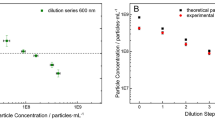Abstract.
Quantitative analysis of particles, especially environmental particles in the submicron region, is hampered mainly by radiation damage. It can already be observed for probe currents smaller than 1 nA and analysis times of 10 seconds. The main reason for radiation damage is the storage of thermal energy in the particle, until the melting temperature is reached, and the subsequent loss of one or more of the elements of the respective material, e.g. SOx in K2SO4. The lower the melting point, the more severe the specimen damage. The amount of specimen damage can vary substantially even for particles of the same size and composition. Specimen damage on inorganic materials can be observed for energies as low as 1 keV.
Thus radiation damage is the greatest obstacle to accurate quantitative analysis for particles in the submicron region, even for analysis times as low as those used in automated particle analysis by CCSEM/EDXS.
Similar content being viewed by others
Author information
Authors and Affiliations
Rights and permissions
About this article
Cite this article
Schmied, M., Poelt, P. Particle Analysis by SEM/EDXS and Specimen Damage. Mikrochim Acta 139, 171–177 (2002). https://doi.org/10.1007/s006040200057
Issue Date:
DOI: https://doi.org/10.1007/s006040200057




